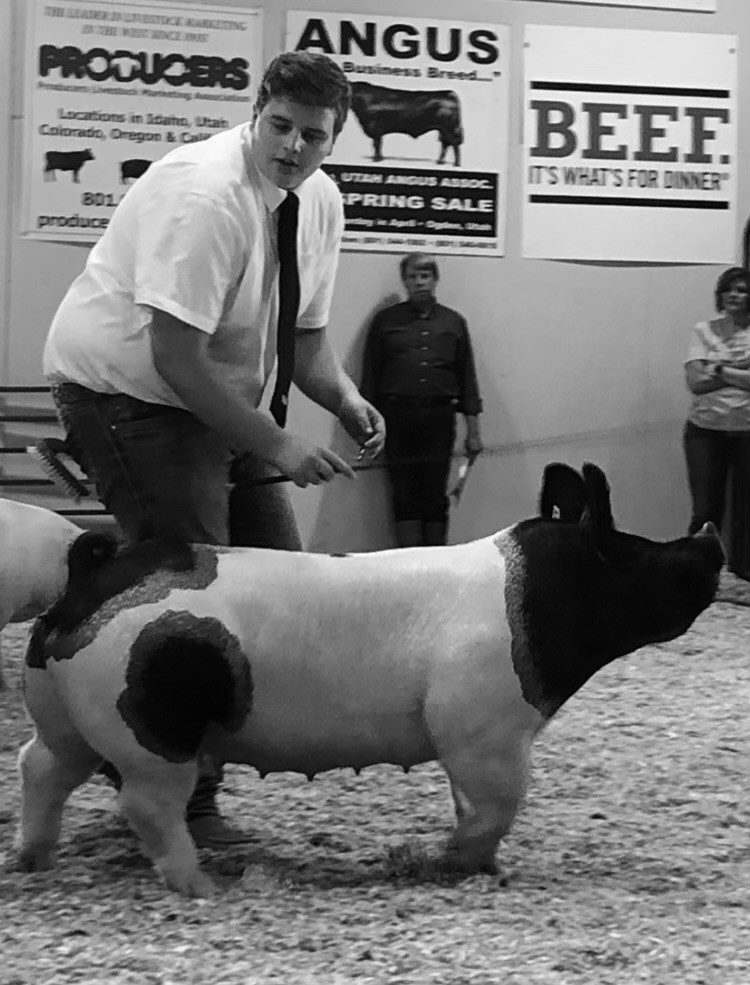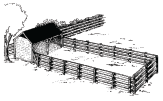First-Time Market Hog

Introduction
Congratulations on your decision to join one of the most hands-on 4-H activities out there! This fact sheet is designed
for first-time steer projects to help prepare and guide you through the basic steps of your 4-H livestock project.
Preparation
Registering for 4-H

Contact your local Utah State University Extension 4-H office to find out how to join a 4-H club and where to register for 4-H.
Reading the Rules
Determine where you plan to show your animal and read the rules and requirements for your project, including information like:
- Tagging dates.
- Ownership length requirements.
- Minimum and maximum weights.
- Show dates, check in-dates, weigh days.
- Rules related to the specific show.
Finding a Mentor
Find a mentor who has shown steers before to help guide you through the process. This can be an older 4-H or FFA member, a leader, or a community member who has shown in the past.
Developing a Budget for Common Expenses

It is important to understand where and how your money is working for you when it comes to raising 4-H project animals. Tracking your expenses and incomes will help you decide future management decisions like selection, housing, supplements, feed, and transportation. Some common areas to consider include the following.
-
- Purchase amount: Shop around and see what show steers in the area are selling for. Steer prices will vary widely depending on quality, breeder, breed, etc. The important part of budgeting is having a price limit in mind that you can afford and then shopping around for animals that fit in that price range.
- Housing: Animals should be penned in areas with proper footing, ventilation, shade, and free from any objects that may cause harm. Additionally, build pens with materials that will keep your project animals in and predators out.
- Water: All show animals need access to fresh water. Water should be kept in the shade and cleaned out regularly.

- Feed: Consult with your local feed store or 4-H group leader to learn more about hog nutrition. As a rule, growing show hogs should eat approximately 4% of their body weight per day in dry matter. As animals mature and growth slows down, that will decrease to 3% per day.
- Vet care: While there usually are not many vet care expenses for a market animal, you should always budget several hundred dollars in case you must address an emergency. Talk to your breeder or vet to make sure all vaccinations and wormers are up-to-date.

- Routine preventative care: Remember you are raising an animal destined for food production, so there are withdrawal periods on medications that apply to your animal. Please read each label carefully and consult a veterinarian before any treatment.
- Supplies: To properly prepare and manage your animal for your desired show, consider the following must- haves.
- Cleaning/Conditioning shampoo. Wash and clean the hog regularly. Condition your hog’s skin regularly to promote healthy skin and hair.
- Whip. Find a whip that is the right size, length, and stiffness that works for you. This is how you will train your hog to walk.
- Hog brush. There are various types of brushes to use, but make sure the bristles are soft enough to not create welts or bruising. These are used for grooming and for touch-ups in the show ring.

- Sprayer. Use a sprayer to help keep hogs cool.
Sunscreen/Moisturizer. Hogs can get sunburned, and their hide becomes dry. There are assorted products available to help care for the hide. - Show products (optional). There are products used on show day, such as finishing sprays and whiteners.
- Cleaning/Conditioning shampoo. Wash and clean the hog regularly. Condition your hog’s skin regularly to promote healthy skin and hair.
Select an Animal
Finding a Breeder
Contact a reputable breeder in your area. Ask kids in the community who have shown where they get their animals and what they look for in a breeder. Most breeders are willing to help with a feed program and progress reports throughout your project. There are also many online sale sources. Join local livestock social media pages to find more options.
Choosing the Right Size
Select an animal that will be the right size for your county fair. You will want your hog to be between 6–8 months of age when you show it and average 240–280 pounds. You will usually select your animal at around 12 weeks of age, and it should weigh around 50 pounds. Check your local rules to ensure you know the minimum weight requirement for fair weigh-in.
Bring Your Animal Home
Housing

- Have a safe and secure pen set up, including clean water and feed. Make sure it provides shelter from the sun, wind, and rain. Keeping a hog cool during hot weather is extremely important.
- Using shavings or straw in the pen helps keep your hog comfortable and clean. Pens should be cleaned daily.
Feeding and Gaining Weight

- Try to find out what the breeder has been feeding your animal, purchase the same food, or get a small quantity from the breeder to make a gradual shift to a food of your choice.
- Check with your local feed companies to see what food they have for your species of animal and how fresh and frequently they get it in stock.
- Do not mix feed across species; some feeds can be toxic to other species.
- Pick a feed and stick with it! It can cause stomach upset if you are constantly switching feed. It can also decrease weight gain.
- Regularly weigh your animal and adjust the feed.
- Check with your local FFA chapter; they usually have summer weigh days.
- Average daily weight gain will vary depending on your destination show but should range somewhere between 1–2 pounds per day.
- Hogs should have an automatic water system that provides constant, clean, fresh water.
Training
- Spending time in the pen with your hog is the first step in the training process. Build a trusting relationship with your hog.
- Slowly start getting your hog out of its pen and accustomed to its surroundings.
- Don’t be afraid to let your hog out of its pen; once it knows where home is, it’s not going to run away.
- Start using your whip to train your hog to walk, keep its head up, and change directions.
Exercising

- Start walking your hog for 10 minutes and slowly work up to 45–60 minutes per day.
- Keeping your hog in shape is vital for show day.
Managing Health
- Deworm your animal when you first bring it home. Follow your local veterinarian’s advice for frequency, dosage, and type of wormer to use.
- Watch for any abnormal health concerns and contact a veterinarian immediately if you observe any of the following:
- Diarrhea.
- Not eating or drinking.
- Coughing.
- Lameness.
- Scabs or hair loss.
- Nasal and eye discharge.
Grooming
- At about 4 to 6 weeks before showing, wash your hog weekly to bi-weekly to help remove dead skin. Make sure to use a gentle soap, such as a coconut-based one. Avoid dish soaps, like Dawn®, to avoid cracking the hog’s hide.
- Starting a month before the show, brush the hair daily to train it to lie down properly.
- Routinely check for mange, lice, and other skin issues to correct before showtime.
- If needed, use lotions or moisturizers to care for the hog’s hide
Photo Credits
The cover page image is courtesy of D. Lister and used with permission; the other photo was provided by Utah State University Extension.
References
- Gosz, R., & Bacon, C. (2017, February 1). Swine showmanship [Fact sheet]. Oklahoma State University. https://extension.okstate.edu/fact-sheets/swine-showmanship.html
- Nutrena. (n.d.). Daily hog care. https://www.nutrenaworld.com/blog/dailyhogcare#:~:text=At%20least%2030%20days%20or,any%20additional%20sprays%20or%20lotions.
April 2024
Utah State University Extension
Peer-reviewed fact sheet
References
- Complete Guide to Home Canning (Agriculture Information Bulletin No. 539). 1994. USDA & Extension Service.
- Drost, Dan. 2005. Beans in the Garden. Utah State University Extension. Logan, Utah.
Authors
Ashley T. Longmore, USU Extension Assistant Professor,Box Elder County
Cheyenne A. Reid, USU Extension Assistant Professor,Uintah County
Related Research


 Staff Resources
Staff Resources
